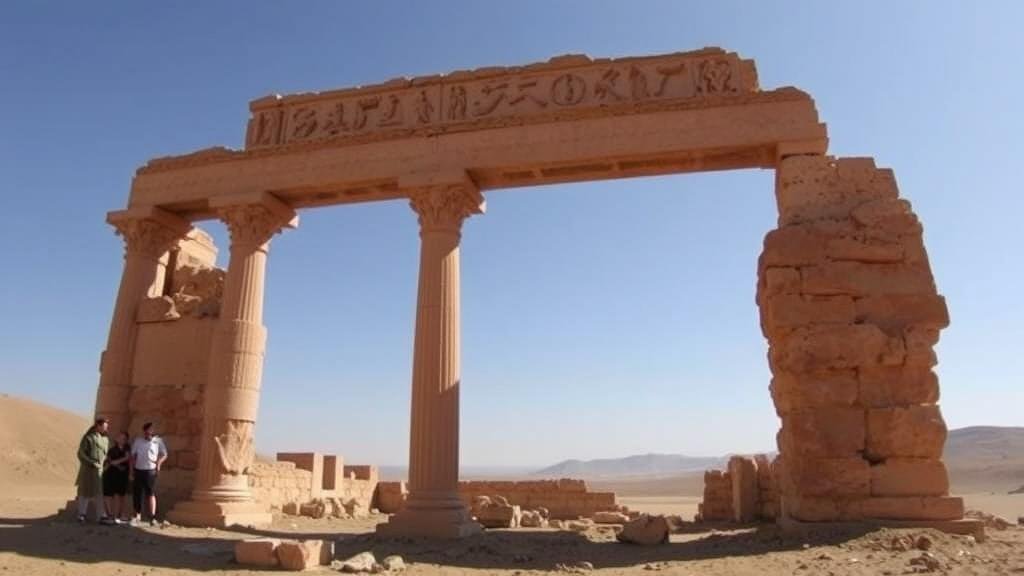Exploring the ruins of Timgad, the lost Roman city buried in Algeria’s sands.
Exploring the Ruins of Timgad: The Lost Roman City Buried in Algeria’s Sands
Nestled amidst the arid landscape of northeastern Algeria lies Timgad, an awe-inspiring testament to Roman civilization. Often referred to as the Pompeii of North Africa, Timgad is a UNESCO World Heritage site that offers a captivating glimpse into ancient life during the Roman Empire. Founded in 100 AD by the Emperor Trajan, this city was strategically positioned to serve as a military outpost and later evolved into a vibrant urban center.
The Origins and Significance of Timgad
Timgad was established primarily to facilitate the Roman expansion into North Africa. Its location, near the Aurès Mountains, provided a natural defense while also serving as a pivotal trade route between the Mediterranean and the Sahara. The city was meticulously planned, featuring a grid layout that was ahead of its time, incorporating a forum, basilica, triumphal arches, and a network of roads that exemplified Roman ingenuity.
- The city was home to approximately 15,000 inhabitants at its peak.
- Timgads construction is a prime example of Roman urban planning, including its grid design based on a rectangular layout.
- One of the most notable structures is the impressive Arch of Trajan, commemorating the founding of the city.
Architecture and Urban Development
The architectural legacy of Timgad is particularly noteworthy. The city boasts an impressive collection of ruins, with structures that include:
- Basilica: A central religious and administrative space that illustrates the significance of civic life.
- Theater: Capable of seating 3,500 spectators, this venue was used for performances and public events, emphasizing the cultural richness of the city.
- Public Baths: These baths served not only as a place for hygiene but also as essential social hubs, highlighting the Roman emphasis on community.
Many buildings retain mosaics that showcase breathtaking artistry, providing insight into the daily life and customs of the ancient inhabitants. For example, the intricate geometric patterns and mythological scenes found in the mosaics reflect both cultural influences and the aesthetic values of the time.
Decline and Rediscovery
Despite its prosperity, Timgad faced a decline beginning in the 3rd century AD due to factors such as economic difficulties, military incursions by barbarian tribes, and shifting trade routes. By the 7th century, the city was largely abandoned and gradually faded into obscurity, buried under centuries of sand.
The rediscovery of Timgad in the 18th century sparked interest among archaeologists and historians. Systematic excavations began in the 19th century, revealing the citys extensive layout and rich artifacts. Today, over 12,000 hectares of ruins can be explored, allowing visitors to traverse the streets once walked by Romans.
Visiting Timgad: A Journey Through Time
For modern-day explorers, visiting Timgad is a journey into the heart of Roman history. The site is open to visitors, and guided tours provide valuable insights into various structures. Key attractions include:
- The Forum: The central square bustling with activity, representing the heart of civic life.
- The Library: Once a repository of knowledge, its remnants remind us of the value placed on education in Roman culture.
- The Markets: Areas where trade thrived, providing a glimpse into commerce and daily living in ancient times.
In recent years, the site has seen increased tourist activity, bolstered by its recognition as a UNESCO World Heritage Site in 1982, which highlights its cultural and historical significance. archaeological site, set against the backdrop of the Sahara, offers both stunning views and a deep appreciation of human ingenuity.
Conclusion: The Timeless Essence of Timgad
Exploring the ruins of Timgad allows visitors to connect with the rich tapestry of history that shaped not only North Africa but also the broader Mediterranean region. This lost Roman city serves as a powerful reminder of the past and an important site for both education and preservation. Whether you are a history enthusiast, an archaeologist, or simply a curious traveler, Timgad invites you to uncover its ancient stories buried beneath the sands of time.
Actionable Takeaways:
- Plan your visit to Timgad when exploring Algeria to appreciate its historical significance fully.
- Engage with local guides for a richer understanding of the archaeological features.
- Consider the broader implications of Roman architecture and urban planning as they relate to contemporary urban development.



